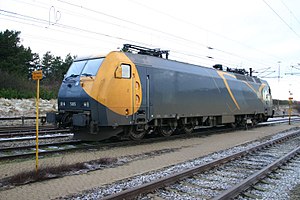DSB EG
| DSB EG / RDK EG / RSC EG DBCSC EG |
|
|---|---|
| Numbering: | EG 3101-3113 |
| Number: | 13 |
| Manufacturer: | Siemens |
| Year of construction (s): | 1999: EG 3101-3103 2000: EG 3104-3113 |
| Axis formula : | Co'Co ' |
| Gauge : | 1435 mm |
| Length over buffers: | 20 950 mm |
| Service mass: | 132 t |
| Wheel set mass : | 22 t |
| Top speed: | 140 km / h |
| Continuous output : | 6500 kW |
| Starting tractive effort: | 400 kN |
| Power system : | 25 kV, 50 Hz 15 kV, 16.7 Hz |
| Power transmission: | Overhead line |
| Train control : | DK-ATC S-ATC D-Indusi |
|
UIC no. : 91 86 0103 101 to 113-Y DK-DBCSC Y = control digit |
|
The DSB EG series are six-axle electric locomotives from the locomotive family known as EuroSprinter from Siemens Transportation Systems . They were built for the Danske Statsbaner (DSB).
history
With the construction of the Great Belt crossing , the need for a powerful electric locomotive arose. On the up to 15.6 ‰ steep incline in the Great Belt Tunnel, if half of the traction equipment fails, the remaining tractive power should be sufficient to leave the tunnel with a 2000 ton freight train. This requirement led to the construction of a six-axle locomotive with two three-axle powered bogies .
Based on the modular technique of freight locomotive Class 152 of the Deutsche Bahn AG were used in the locomotives of DSB proven standard components and systems developed by Siemens and Krauss Maffei traffic engineering Euro Sprinter family of the second generation are used.
It was procured in 1999 and 2000 in a number of 13 copies.
technology
The machines are equipped for operation under two power systems (Denmark and Sweden / Germany) and have train control systems for Denmark, Sweden and Germany. As the locomotive was designed with six axles, but the modular principle with the transformer installed between the bogies should be changed as little as possible , two three-axle bogies were installed. The starting tractive effort is 400 kN compared to the 300 kN of a comparable four-axle locomotive. This makes it one of the most powerful traction vehicles in the European rail network.
The EG has a multiple traction facility with which further locomotives of the same series as well as the EA series can be driven. The locomotives are equipped with the train control systems Automatic Train Control (ATC) for Denmark, ATC Sweden for Sweden and PZB in three-frequency resonance design for Germany.
Now that the European Train Control System (ETCS) has been implemented on the track side in Denmark and Sweden , the need to equip this series of locomotives has also arisen. For financial support, DB Cargo submitted an application to the EU as part of the Connecting Europe Facility (CEF). However, this was initially rejected due to contradicting data and excessive costs for the prototypes contained.
RDK EG
The locomotives procured for DSB Gods were handed over to Railion Danmark A / S in 2001 . There they received the new owner designation RDK EG .
In December 2007, Railion and Green Cargo signed a joint venture agreement, according to which Green Cargo holds a 49% stake. As part of the reorganization of the Deutsche Bahn brand identity in December 2007, the name was changed to DB Schenker Rail Scandinavia A / S shortly after it was founded .
RSC EG

The change of name to DB Schenker Rail Scandinavia A / S resulted in a change to RSC EG in 2007 . From 2010 the locomotives were repainted in DB Schenker colors traffic red, there is a gray area below the driver's cab side window. These repaints were completed in 2014. The machines were given Danish UIC vehicle numbers while retaining the previous digits as eight to eleven digits.
DBCSC EG
1 March 2016, changed DB Schenker Rail Scandinavia A / S changed its name to DB Cargo Scandinavia A / S with the property abbreviation for vehicles ( english Vehicle Keeper Marking ) DBCSC. This gave the locomotive series a new owner designation.
commitment
The machines are mainly used for transit freight trains through Denmark, between the freight stations in Malmö and Maschen (2003, 2004 and again since December 2008).
literature
- Eisenbahn-Kurier Edition 7/2004, pp. 116–120, EK-Verlag, Freiburg 2004.
- Eisenbahn-Kurier edition 9/2004, p. 94, EK-Verlag, Freiburg 2004.
Web links
- FAG wheelset bearings in the EG 3100 locomotive for the DSB Gods. (PDF) schaeffler.com, accessed on April 20, 2017 .
- EG DSB gods / Railion DK / DB Schenker. jernbane.net, accessed April 20, 2017 (Norwegian).
- DSB EG. jernbanen.dk, accessed April 20, 2017 (Danish).
- The EG 3100 of the Danish State Railways. Archived from the original on September 19, 2003 ; Retrieved April 20, 2017 .
Individual evidence
- ↑ 2017 Transport Blending call - Proposal for the selection of projects (first cut-off). (PDF; 17.4 MB) In: Website. European Commission, December 12, 2017, p. 81 , accessed January 5, 2018 .
- ↑ eisenbahn-magazin 7/2010, p. 15
